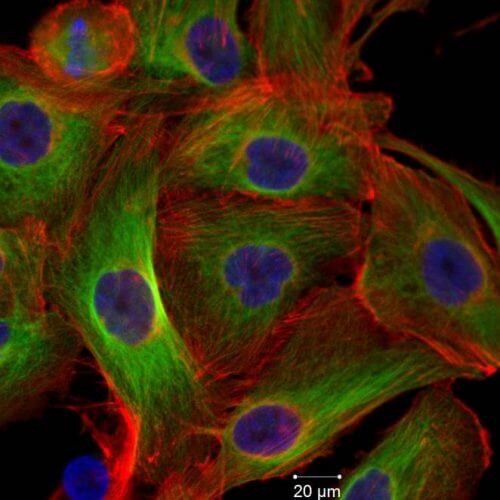Researchers at Tel Aviv University have developed a new approach for the targeted elimination of aggressive cancer cells by igniting a self-destructive mechanism in the cell.

Researchers at Tel Aviv University have discovered how to harness a natural rapid death mechanism that exists in every cell, and protects against errors in cell division, in order to eliminate violent cancer cells that are resistant to existing treatments.
The research was carried out under the leadership of Prof. Malka Cohen-Armon from the Department of Physiology and Pharmacology at the Faculty of Medicine of Tel Aviv University, in collaboration with the groups of Prof. Tamar Peretz at the Sharet Oncology Institute at the Hadassah Ein Kerem Medical Center, and Prof. Shay Yazraeli and Dr. Talia Golan at the Cancer Research Center at the Center Sheba in Tel Hashomer. The article was recently published in the journal Oncotarget.
"Already in 2009, we discovered that molecules that are derivatives of phenanthridines (tricyclic hydrocarbons) effectively kill metastatic breast cancer cells that do not respond to conventional treatments," says Prof. Cohen-Armon. "We then tested the effect of the molecules on treatment-resistant cells, taken from other types of malignant tumors in humans - ovarian cancer, colon cancer, pancreatic cancer, a rare type of brain cancer and lung cancer - and discovered that these molecules kill them all very efficiently, within 96 -48 hours. At the same time, we found that the procedure does not cause any damage to healthy cells, and that its damage to the cancer cell occurs during the cell division phase (mitosis). Following these findings, we asked to investigate the elimination mechanism."
To reveal the mechanism by which phenanthridine derivatives kill the cancer cell, the researchers scanned the response to phenanthridine of all proteins in the cell known to be associated with the process of cell division. In this way, they identified a number of specific proteins, which undergo a change under the influence of phenanthridine only in the cancer cell, while in the healthy cell they do not react to it at all.
Prof. Cohen-Armon explains: "In a normal division process, the chromosomes of the mother cell replicate precisely, and the two sets of chromosomes that are created line up opposite each other along the width of a spindle with two poles, which is formed in the mother cell. The proteins we identified in the scan are responsible for building the skill and arranging the chromosomes during division. In cancer cells, phenanthridine disrupts their activity, and as a result, a small depleted and distorted competence with scattered chromosomes is formed in the cancer cell. In order to prevent the cell from dividing abnormally, following the malfunction the cell "suicides" - a natural rapid death mechanism is triggered in the malignant cell - which comes into action in any cell that does not divide normally, and thus the cancer cells are destroyed by the treatment. More than that: since the injury is in the cell division phase, the effectiveness of the treatment increases in cancer cells that divide at a high rate - mostly in particularly violent malignant tumors."
After testing the mechanism in cell cultures in the laboratory, the researchers wanted to test its effectiveness in mice implanted with human cancerous tumors. The result was promising: following the treatment with phenethridine, the development of the tumors stopped, and about two weeks later, the tumors in the treated mice were significantly smaller than the tumors in the control group that remained untreated.
"We believe we have identified a new and particularly effective mechanism for cancer treatment, which may be suitable for a variety of malignant tumors," concludes Prof. Cohen-Armon. "We intend to develop molecules that disrupt the activity of the proteins we have identified, thus harnessing the natural mechanism of rapid death during cell division to eliminate violent cancer cells. Later we will examine the feasibility of these molecules for use as medicine in humans."

5 תגובות
Revolutionary and wonderful news. Great blessing.
Reminds me of the joke about the proper way to curse a doctor so that the doctor will also be happy about it: "May everyone be healthy"
Kosher and happy holiday to all the people of Israel
To Professor Aramon
I read the article again and I'm glad I misunderstood it.
If the healthy cells are not damaged then this is really a tremendous progress.
From an experience with a relative who underwent chemotherapy, the chemotherapy damaged the cancer but also caused the development of a blood infection due to the damage to the body's resistance to bacteria. The relative almost did not survive the chemotherapy treatment and they had to stop the chemotherapy in the end and went to a surgical operation.
I would be happy if someone from the research would contact me on the matter.
my mail sevdermishy@gmail.com
Amazing, congratulations!
What are the steps now that the technology must go through in order to enter public use?
How long does something like this take, assuming everything goes well?
Yehuda Sabdarmish,
Unfortunately, you missed the main point of the article. The healthy cells are not damaged by the treatment.
This mechanism of attacking the dividing cells already exists today and it damages not only the cancer cell but every cell that divides during the chemotherapy phase. For example, blood cells that attack cancer and fight it also divide during their fight against cancer and are therefore attacked by chemotherapy. Why is this similar, to the battle you are fighting and in order to succeed in the battle you also destroy your fighting forces.
Perhaps the aforementioned chemotherapy material is better, but there is still room for improvement.
Good night
Yehuda